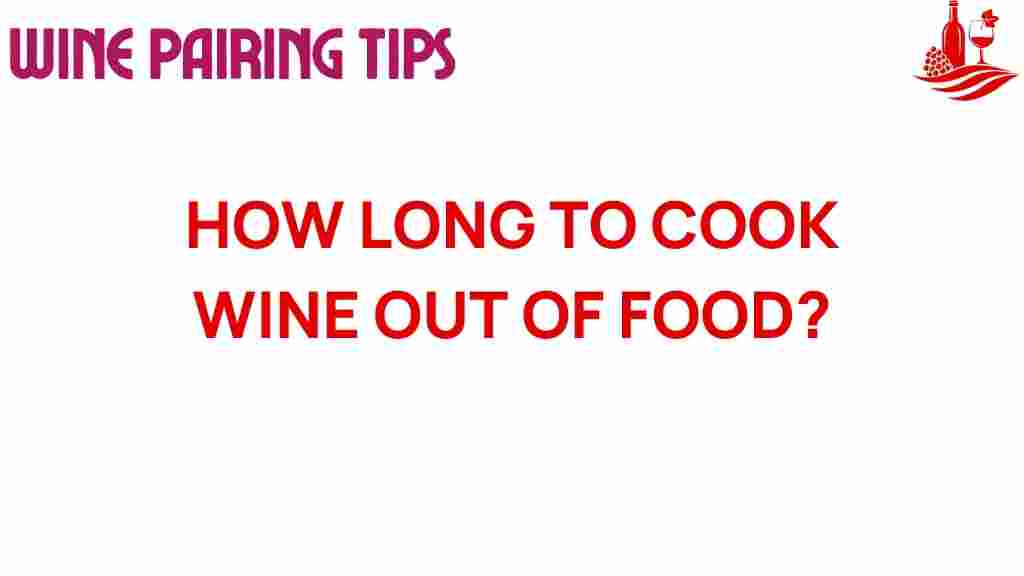The Science Behind Cooking Wine Out of Food: How Long Is Enough?
When it comes to cooking, the right ingredients can elevate a dish from ordinary to extraordinary. One such ingredient that often enhances flavors and adds depth to meals is cooking wine. However, a common question arises: how long should you cook with wine to ensure the alcohol cooks out while still retaining the delicious flavors it contributes? In this article, we will explore the science behind cooking wine, culinary techniques for effective wine reduction, and provide you with essential cooking tips for recipe improvement through kitchen experiments.
Understanding Cooking Wine
Cooking wine is typically a type of wine specifically crafted for culinary purposes. It often contains added salt and preservatives, making it unsuitable for drinking. However, when used in cooking, it can significantly enhance the flavor profile of dishes, especially in sauces, marinades, and braises.
Cooking with wine involves several culinary techniques that can transform a dish. The key to making the most out of cooking wine lies in understanding how it interacts with food and how long it should be cooked to achieve the best flavor without the strong presence of alcohol.
The Science of Cooking Wine Reduction
When cooking with wine, two main processes occur: evaporation and reduction. Evaporation refers to the process where the alcohol and some water content in the wine escape into the air, while reduction is the concentration of flavors as the liquid volume decreases. Understanding these processes is crucial for effective cooking with wine.
How Long to Cook Wine?
Many factors influence how quickly alcohol cooks off. Here’s a breakdown:
- Cooking Method: Simmering or boiling wine will expedite the cooking process. Sautéing with wine may take longer to reduce.
- Temperature: Higher temperatures lead to quicker evaporation of alcohol. However, excessive heat can alter flavors.
- Surface Area: A wider pan allows for more evaporation compared to a narrow one.
- Wine Type: Different wines have varying alcohol content and flavors, which can influence the cooking time.
Generally, here are some guidelines for cooking with wine:
- 15 minutes: Most of the alcohol will evaporate, but some will remain.
- 30 minutes: Approximately 35% of the alcohol remains.
- 1 hour: Around 25% of the alcohol remains.
- 2 hours: About 10% of the alcohol remains.
- 3 hours: Almost all alcohol is evaporated, but the flavor is still rich.
Step-by-Step Process for Cooking with Wine
Here’s a simple guide to effectively cook with wine to maximize flavor enhancement without the strong taste of alcohol:
1. Choose the Right Wine
Select a cooking wine that complements your dish. For example:
- Red Wine: Beef stews, marinades, and robust sauces.
- White Wine: Chicken dishes, seafood, and creamy sauces.
- Cooking Sherry: Excellent for soups and Asian dishes.
2. Prepare Your Ingredients
Before you start cooking, gather all your ingredients. This way, you can maintain a steady cooking process without interruptions.
3. Heat the Pan
Use a heavy-bottomed pan for even heat distribution. Preheat it over medium heat before adding your ingredients.
4. Add Cooking Wine
Once your ingredients are partially cooked, add the cooking wine. This step allows the wine to deglaze the pan, lifting the fond (the caramelized bits) from the bottom.
5. Simmer
Allow the wine to simmer. The longer you simmer, the more the flavors will concentrate, and the less alcohol will remain. Aim for at least 15-30 minutes depending on the desired outcome.
6. Taste and Adjust
As the dish nears completion, taste it. You may want to add more cooking wine or other seasonings based on your preference.
7. Serve and Enjoy
Once the dish is finished, serve it hot and enjoy the enhanced flavors from the cooking wine.
Troubleshooting Tips
While experimenting in the kitchen, you may encounter some challenges. Here are some common issues and solutions:
- Too Strong of a Wine Flavor: If the wine flavor is overpowering, cook the dish longer to allow for more reduction. You can also add a bit of broth or cream to balance it out.
- Wine Not Cooking Off: Ensure that you are using a wide pan and cooking over medium to high heat to facilitate evaporation.
- Dish Lacking Depth: If the dish tastes flat, consider adding a splash of wine at the end of cooking for a fresh burst of flavor.
Kitchen Experiments with Cooking Wine
Don’t be afraid to experiment in the kitchen! Here are some ideas for kitchen experiments using cooking wine:
- Marinades: Try using different wines in marinades to see how they affect the flavor and tenderness of meats.
- Deglazing: Experiment with deglazing different proteins and vegetables with various types of wine to discover unique flavor combinations.
- Reduction Sauces: Create sauces by reducing wine with various herbs and spices, adding different flavor profiles to your dishes.
These kitchen experiments can lead to exciting discoveries and improvements in your recipes. Additionally, documenting your results can help you refine your cooking techniques over time.
Conclusion
Cooking with wine is an invaluable skill that can greatly enhance your culinary creations. Understanding the science behind cooking wine and how long to cook it for optimal flavor retention is essential for any home cook. By mastering the art of wine reduction and experimenting with different culinary techniques, you can take your recipes to the next level.
Whether you’re a seasoned chef or a novice in the kitchen, applying these cooking tips will not only improve your dishes but also make cooking a more enjoyable experience. Remember, the key is to be patient and allow the flavors to develop while ensuring that the alcohol cooks off. Happy cooking!
For more culinary inspiration, check out this fantastic resource on cooking techniques. And for a deeper dive into food science, visit this food science website for expert insights.
This article is in the category Tips and created by Wine Pairing Tips Team
